

Matt Campbell
2026 Hyundai Tucson Hybrid review
7 Hours Ago
Audi has addressed our greatest criticism of the old e-tron in its transformation to the Q8 e-tron – a welcome boost in range.
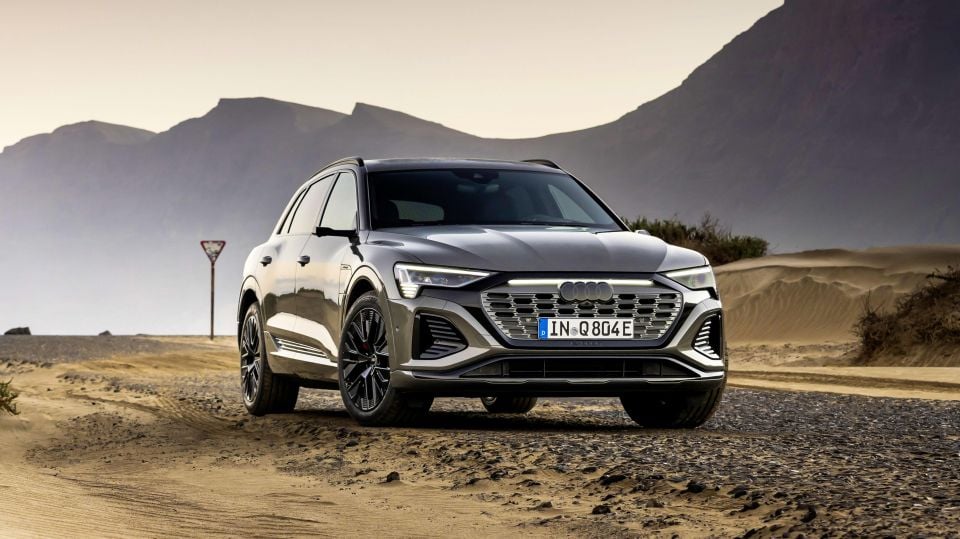


News Editor

News Editor


News Editor

News Editor
Where expert car reviews meet expert car buying – CarExpert gives you trusted advice, personalised service and real savings on your next new car.
The new Audi Q8 e-tron and SQ8 e-tron aren’t simply electric versions of the existing Q8 and SQ8.
Sure they’re related under the skin, sharing their MLB Evo underpinnings, but the new electric SUVs don’t share any sheetmetal with the established Q8 and SQ8.
The Q8 e-tron and SQ8 e-tron are instead rechristened and refreshed e-tron and e-tron S electric SUVs.

But this isn’t just a case of Audi putting on new badges and a new grille and calling it a day. While they may not look dramatically different from their predecessors, the Q8 e-tron and SQ8 e-tron – due here in the second half of 2023 – have received substantial updates under the skin.
All models get a significant increase in range – one of our biggest criticisms of the old e-tron – with larger batteries in all models. There are also retuned chassis control systems, improvements to electric motors, as well as aerodynamic and weight-saving modifications.
The 2023 Audi Q8 e-tron and SQ8 e-tron aren’t entirely new cars as their names would suggest, but they’re clearly more than mere rebadges.
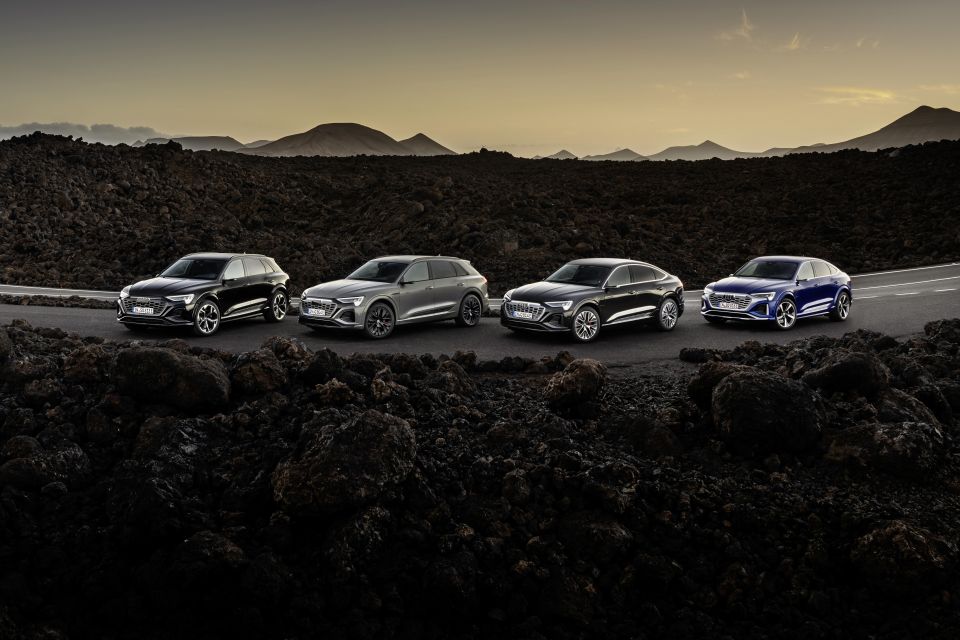
We drove the mid-range Q8 e-tron 55 and the flagship SQ8 e-tron, both in wagon guise. Sportback versions of each were available at the launch event in Lanzarote in the Canary Islands, but the 50 – the most improved of the bunch – wasn’t present.
Audi Australia hasn’t confirmed local pricing and specifications. The outgoing e-tron was offered in base 50 guise locally but this was retired this year, leaving just the 55 and e-tron S with prices ranging from $147,400 before on-road costs to $173,900 before on-roads.
We’d expect price increases across the range given the extra capability, and CarExpert understands the local line-up will be similar to what was on offer with the e-tron previously.
It’ll battle the likes of the BMW iX, the upcoming Mercedes-Benz EQE SUV and Polestar 3. There’s set to be even more activity in this space over the coming years, with Alfa Romeo, Maserati and others planning large luxury SUVs of their own.
The Tesla Model X is an obvious rival, even if it does have an extra row of seating, but it remains off-sale in Australia.
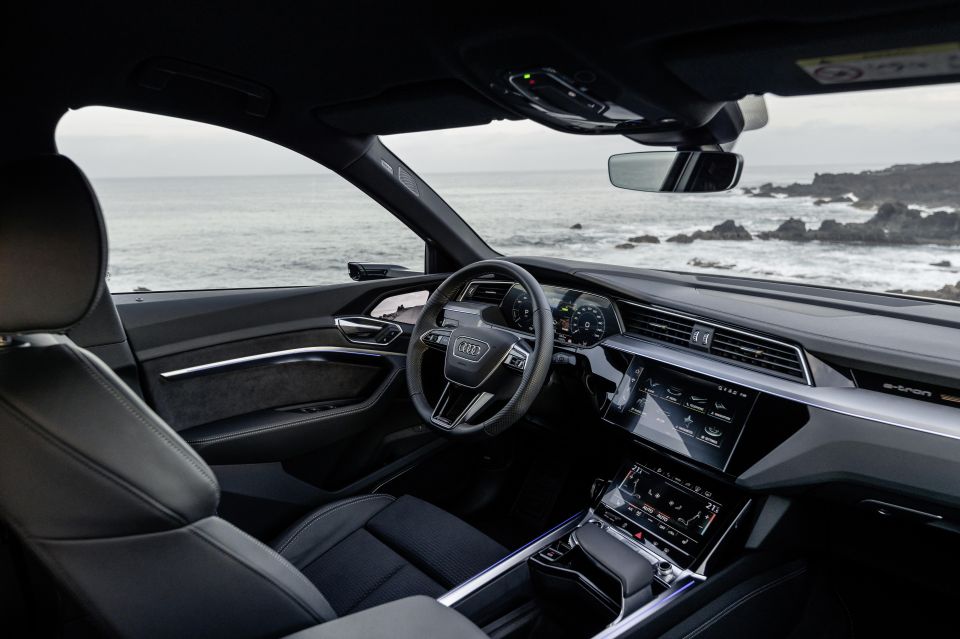
Buy your new car without the stress. It's fast, simple and completely free.

Great service from Travis and team, second time I have used this business would not hesitate to recommend them to anyone
Craig C.
Purchased a Ford Ranger in Sunshine Coast, QLD
CarExpert helped Craig save thousands on his Ford Ranger, now let us save you on your next new car.
Find a dealIf the changes made to the Q8 e-tron’s exterior are subtle, those made to the interior are almost imperceptible.
There are some different inlays available, including a new light brown walnut wood, as well as a new “sustainable technical material” made partially from recycled PET bottles. A red stitching package is also available.
The overall design however is unchanged, including the 10.1- and 8.6-inch displays in the centre stack and the 12.3-inch digital instrument cluster.
The dashboard has always looked rather similar to the Q8/SQ8/RSQ8, if with more angular elements. Material quality, like those combustion-powered models, is hard to fault with soft-touch surfaces used throughout the cabin.
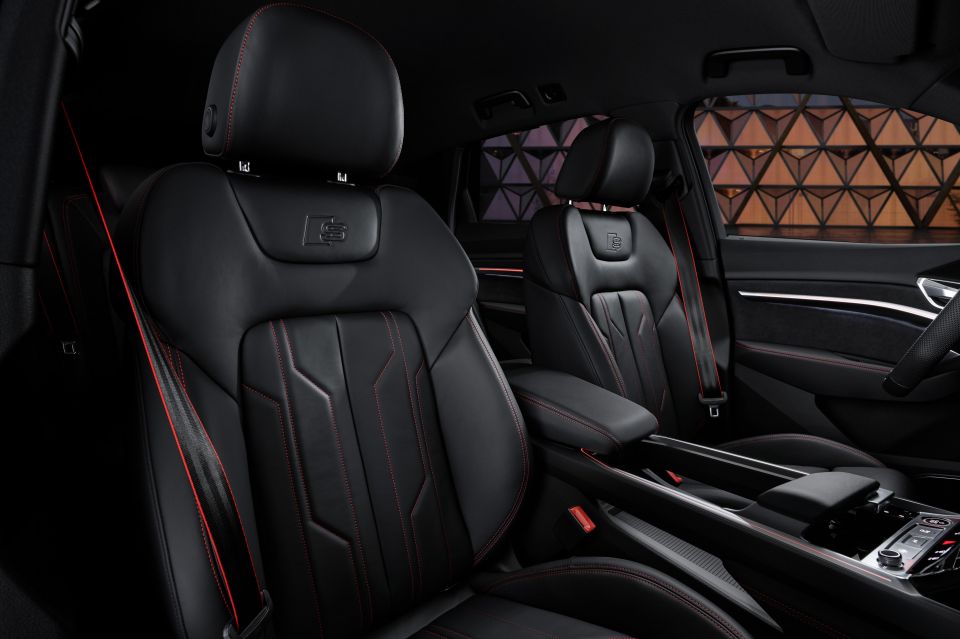
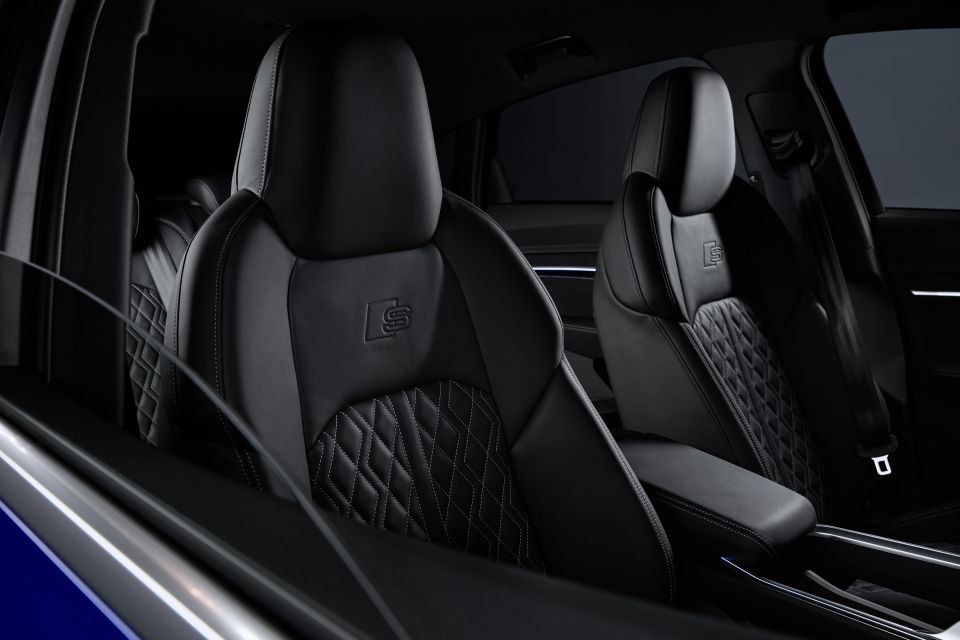
If there was one element of the interior we wished had been changed, it would be the gear selector. The Q8 e-tron has a small (but fiddly) selector that’s attached to a large padded plastic surface that appears to function as some kind of wrist rest.
The actual part you move to change gears is just as small (and fiddly) as many of the Volkswagen Group’s new shifters, but what it’s attached to takes up a great deal of real estate.
The technology in the cabin is superb and there’s no additional learning curve required if you’re stepping out of a Q7 or Q8, though there’s additional information screens for the electric powertrain.
While buttons and knobs are always preferable, the lower display for the climate control is large and legible, while the infotainment screen has haptic feedback, intuitive displays and crisp graphics.
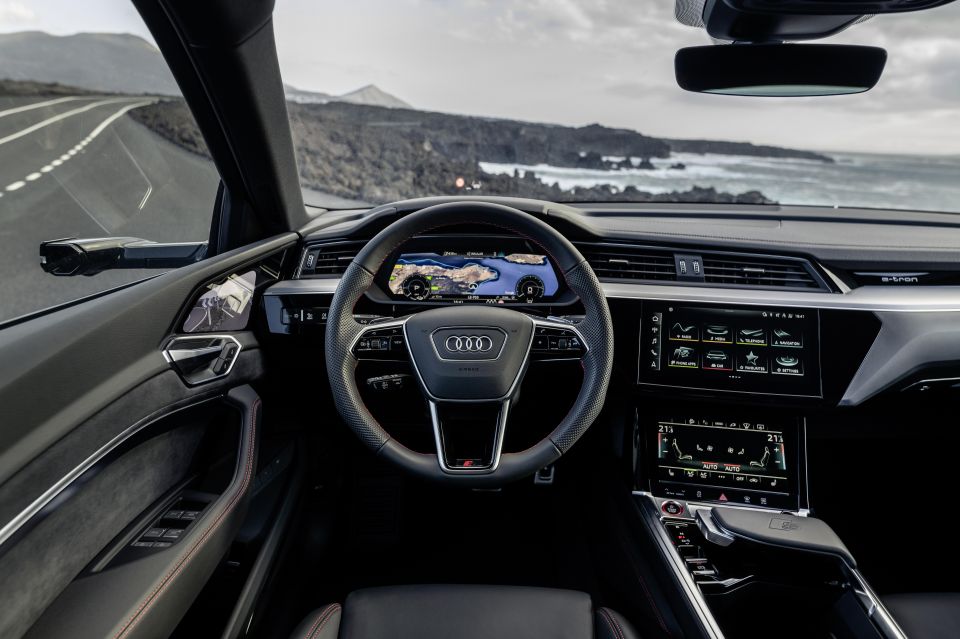
Then there’s the Virtual Cockpit digital instrument cluster, which leaves many rival systems in the dust.
There are multiple views to choose between, and Audi should be lauded for its use of attractive satellite imagery that can be displayed in the cluster and yet somehow doesn’t prove distracting. Audi offers the Q8 e-tron in Europe with either Virtual Cockpit or Virtual Cockpit Plus cluster options, with the latter boasting more views to toggle between.
You may never look down at the cluster as the head-up display is large and displays all the information you’ll need on the fly, though the clever augmented reality arrows of the more affordable Q4 e-tron would be a nice addition.
Storage is good, with a deep bin and a cavernous centre console cut-out, though Audi still hasn’t introduced a cover for this. The bottle holders in the doors also easily swallow 1L bottles.
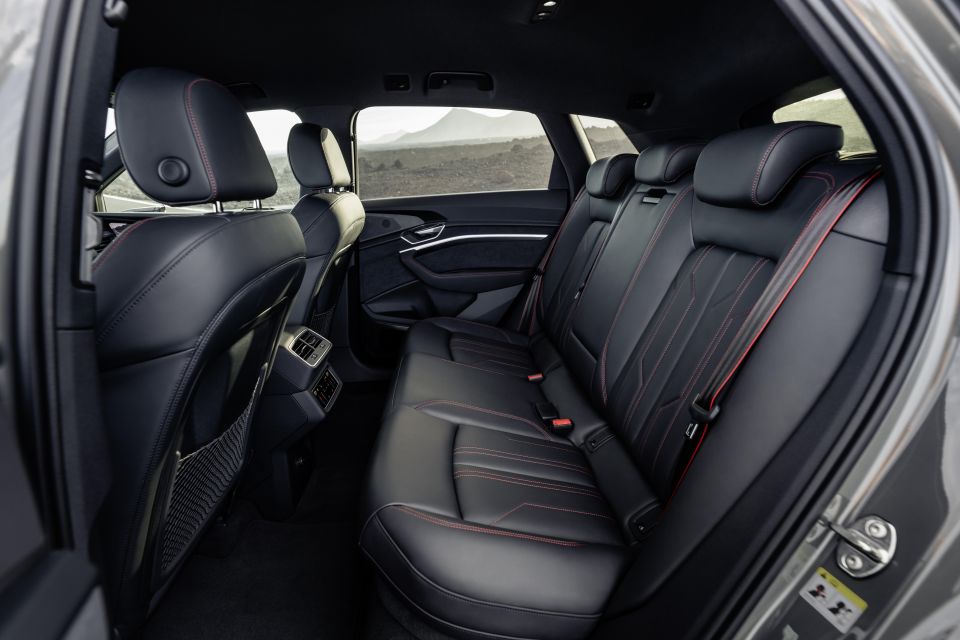
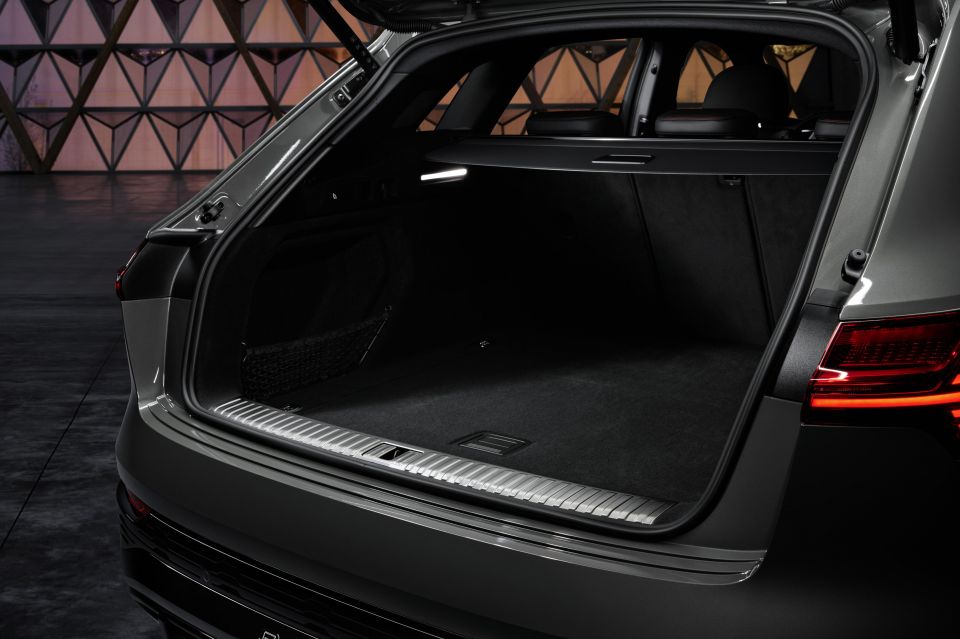
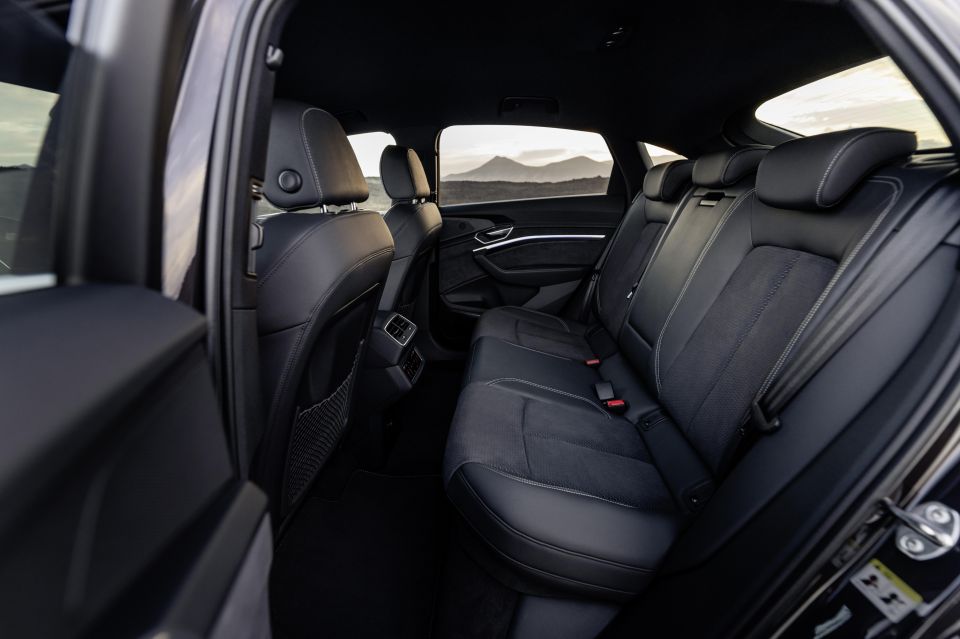
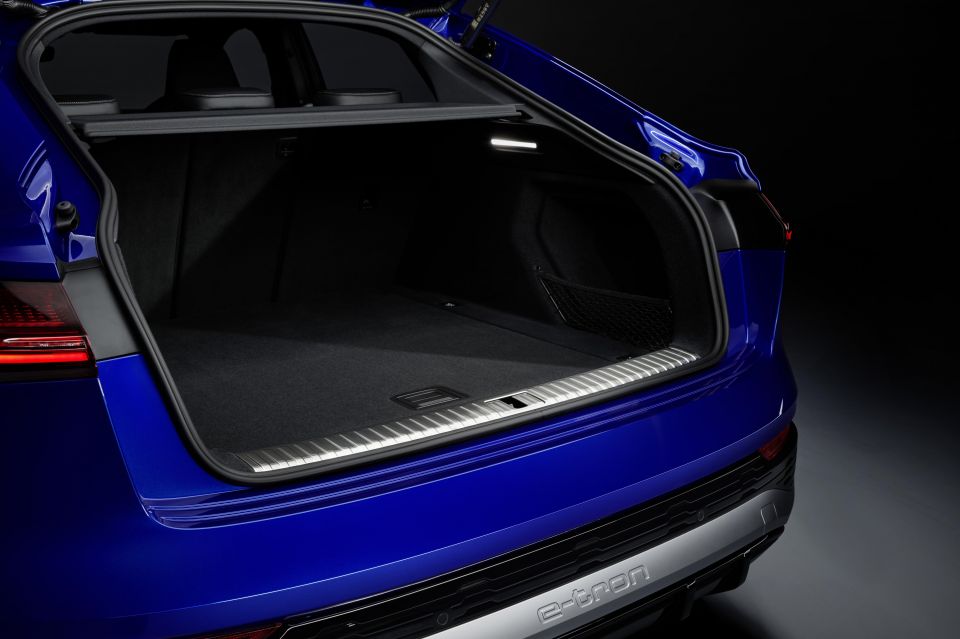
Step into the rear and there’s plenty of space, even in the sleeker Sportback. I’m 180cm tall and had ample leg, knee and head room sitting behind my own seating position.
The floor is quite flat, though the centre console does jut outwards a bit, impinging on the centre-seat occupant’s space.
Amenities include netting on the front seatbacks, a fold-down centre armrest with cupholders and storage, bottle holders in the doors, while models with the available four-zone climate control feature a neat adjustment panel below the centre rear air vents; there are also vents on the B-pillars.
Boot space in the Q8 e-tron with the rear seats in place measures 660L in the wagon and 615L in the Sportback. There’s also 60L in a front boot.

The 50 and 55 feature dual-motor all-wheel drive set-ups, while the SQ8 has an unusual tri-motor set-up.
The base 50 is more powerful than before, with 250kW in boost mode (up 20kW) albeit an unchanged 664Nm of torque. Its 0-100km/h time has been slashed from 6.8 seconds to 6.0 seconds flat. The 55 has 300kW in boost mode and 664Nm of torque and a 0-100km/h time of 5.6 seconds.
The SQ8 e-tron features a 124kW electric motor on the front axle and two 98kW motors down back that separately power a rear wheel. Total system outputs are 370kW (in boost mode) and 973Nm of torque, with a claimed 0-100km/h time of 4.5 seconds.
Speed freaks, some bad news: Audi has no plans for an RSQ8 e-tron as the SQ8’s outputs are the maximum the new battery can support.
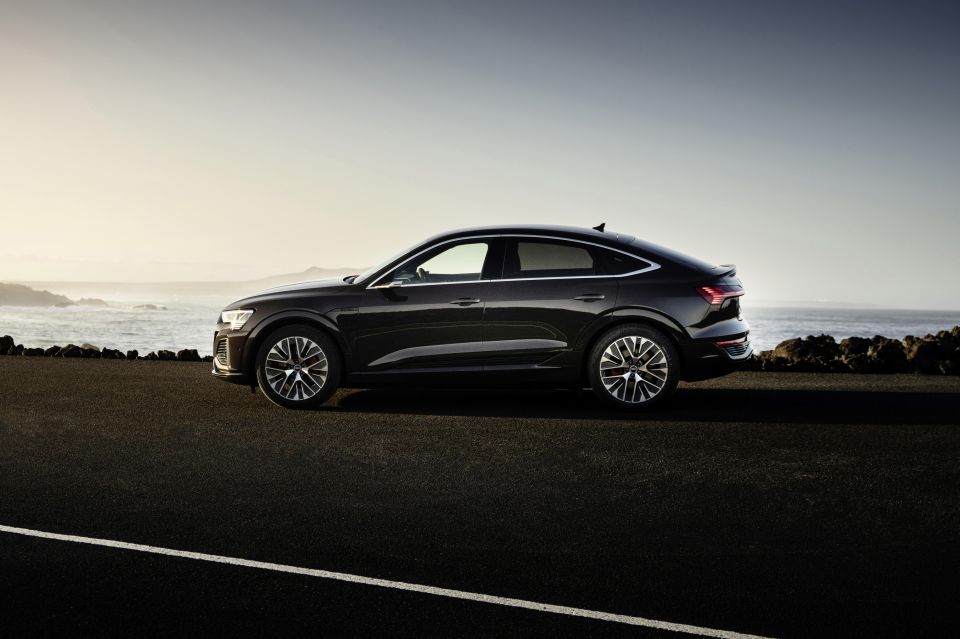
The old e-tron’s 71kWh battery is gone, with the 50 now packing a 95kWh nickel-manganese-cobalt battery. The 55 and SQ8 also receive a new, larger 114kWh nickel-cobalt-aluminium battery.
WLTP range has been increased by up to 30 per cent on the 55 and SQ8, and by 40 per cent on the base 50.
Claimed range figures are as follows:
Considering the old e-tron 50 had just 336km of range and even the 55 managed just 436km, those are some significant improvements. The e-tron 50 now eclipses the BMW iX xDrive 40 (420km) and the 55 comes closer to the xDrive 50 (620km), though the iX M60 has the SQ8 beat (566km).

In addition to greater range than before, the 50 now supports DC fast-charging at up to 150kW (up from 120kW) and the 55 and SQ8 can be charged at up to 170kW (up from 150kW). All models can be charged at up to 11kW using AC charging, though 22kW capability is optional.
Audi says the charging curve is also more of a plateau with the updated car. Instead of chasing a lofty peak, Audi says it focused on having more consistent charging performance as it believes that’s what its customers prefer.
While charging times haven’t changed much – a Q8 e-tron 55, for example, takes 26 minutes to charge from 20 to 80 per cent and 31 minutes to charge from 10 to 80 per cent – Audi says the car is doing this in the same time with a lot more energy.
Audi says it has also improved efficiency by giving the asynchronous rear electric motor a stronger magnetic field with the addition of two additional copper coils (14 in total) in the stator. Indeed, figures show improvements of up to 9.0 per cent in energy consumption in WLTP testing.
We recorded energy consumption of 24.5kWh per 100km in the Q8 e-tron 55 wagon, though we had less time behind the wheel of this vehicle with a limited, mostly highway-biased 126km drive loop. The official claim is between 20.6 and 24.4kWh per 100km.

We had more time with the SQ8 e-tron wagon, leaving Puerto del Carmen with 379km of range on tap. Our drive route took us through small towns with tight streets and along country roads, though traffic was always sparse.
We recorded energy consumption of 25.8kWh/100km with 204km of driving – against a claim of 24.6 to 28kWh/100km – with 187km of range remaining upon returning the vehicle.
While we were able to more or less match Audi’s energy consumption claims, it’s worth noting the Q8 e-tron and SQ8 e-tron use more energy than a BMW iX.
The official claim for an iX xDrive50, for example, is between 19.8kWh and 23kWh per 100km. We’ll have to see how the Audis fare in a more typical driving environment.
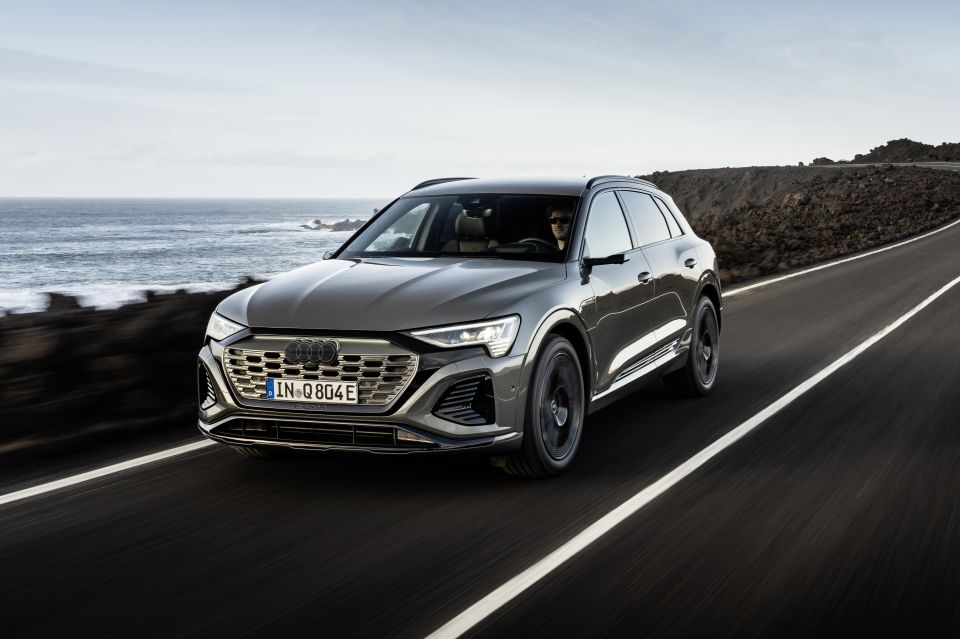
Audi tried to quantify the work its engineers have done to the outgoing e-tron, claiming a 10 per cent improvement in agility and steering precision due to faster steering input and greater responsiveness.
The company also claims a 20 per cent improvement in steering weighting and feedback and a 10 per cent reduction in pitch and roll body movements.
There’s a more direct steering ratio – 14.6, compared to 15.8 in the old e-tron – as well as stiffer front axle lateral control arm bushes and tweaks to the tuning of the adaptive air suspension, electronic stability control and electronic chassis platform.
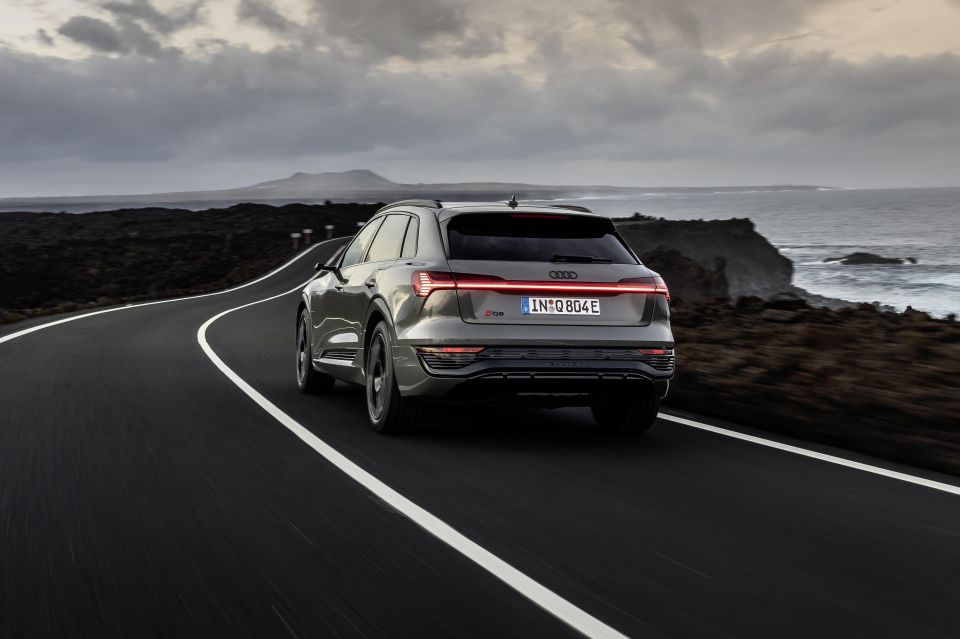
Other changes under the skin include a new underbody plate, shifting from aluminium to glass fibre and shedding 7kg of weight in the process, and new wheel spoilers for Sportback models. Aerodynamic performance has also been improved from 0.26 to 0.24Cd in Sportback models and from 0.28 to 0.27Cd in the wagons.
While the Q8 e-tron has received meaningful enhancements under the skin, the way it drives doesn’t feel fundamentally different.
Audi says its engineers tweaked the damping, acknowledging the outgoing model could feel a bit floaty.
Body control on the 55 is commendable, feeling nicely tied down even on more undulating roads. Mind you, the old e-tron was no pauper in this regard.
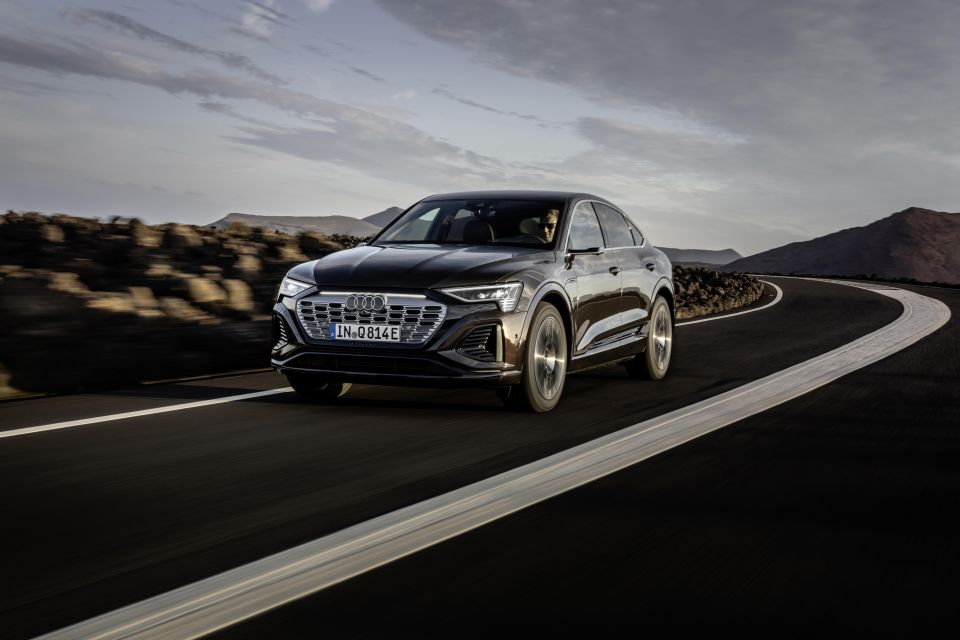
Where expert car reviews meet expert car buying – CarExpert gives you trusted advice, personalised service and real savings on your next new car.
You can choose between off-road, allroad, efficiency, comfort, dynamic, auto and individual drive modes which, depending on the mode selected, alter settings for the steering, power delivery and adaptive air suspension.
Left in auto mode, the 55 errs on the side of firmness but never feels uncomfortable. While Lanzarote roads put Australia’s to shame, we suspect the Q8 e-tron will feel about as sorted as its predecessor on our rougher blacktop.
Body roll is well controlled when the road starts to bend and there’s an impressive level of all-round competence in the way the heavy Q8 e-tron maintains its composure.
The changes to the steering ratio give it a more direct feel, with a comfortable, just-right weighting.

The Q8 e-tron’s cabin is serene, with tyre roar kept to a minimum and wind noise virtually non-existent. There’s a gentle whirring from the electric motors that, while not as mellifluous as the note of an SQ8 or RSQ8’s V8 engine, proves unobjectionable.
Throttle response is smooth and linear and the 55 isn’t lacking for grunt, though it never feels extraordinarily quick, either.
Audi says the SQ8 e-tron offers some of the types of enhancements usually found in RS models, but it won’t call it an RS as it’s not quick or focused enough. That tracks.
There’s no fake propulsion sound like in the e-tron GT or, say, a BMW iX M60. That leaves it to your other senses to detect the difference between it and the regular Q8 e-tron.
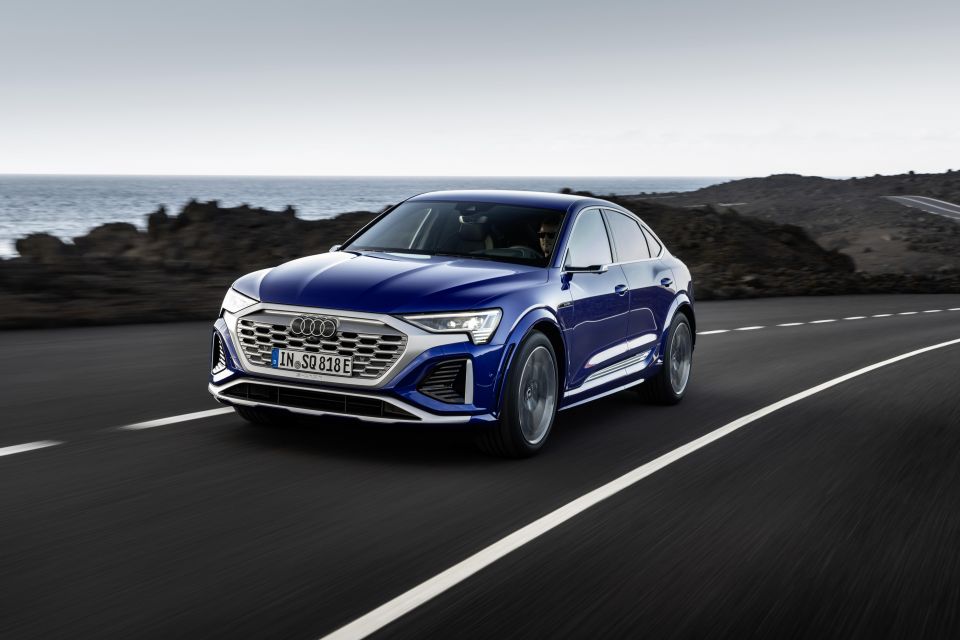
Though it boasts active torque vectoring and a more powerful tri-motor set-up, it doesn’t feel dramatically more entertaining than the regular Q8 e-tron – even if the extra grunt is tangible.
Audi did note, however, this was a pre-production vehicle, with the front electric motor set up to provide power until you need to summon more, at which point the rear motors kick in. The production vehicle will be the inverse, thought Audi said this wouldn’t fundamentally change the feel of the car.
Almost every road we drove on proved quite smoothly surfaced with the exception of one heavily corrugated road out to a farm. The SQ8 e-tron with its large wheels and low-profile tyres despised this, but in fairness to the Audi it was an extraordinarily rough road.
Over sealed but patchy roads around some of the small towns, we had no objections with the SQ8’s ride quality. It feels firmer than the 55, but not to the point of feeling compromised, and there’s perhaps a touch more tyre roar. That means it’s still a capable and comfortable cruiser.
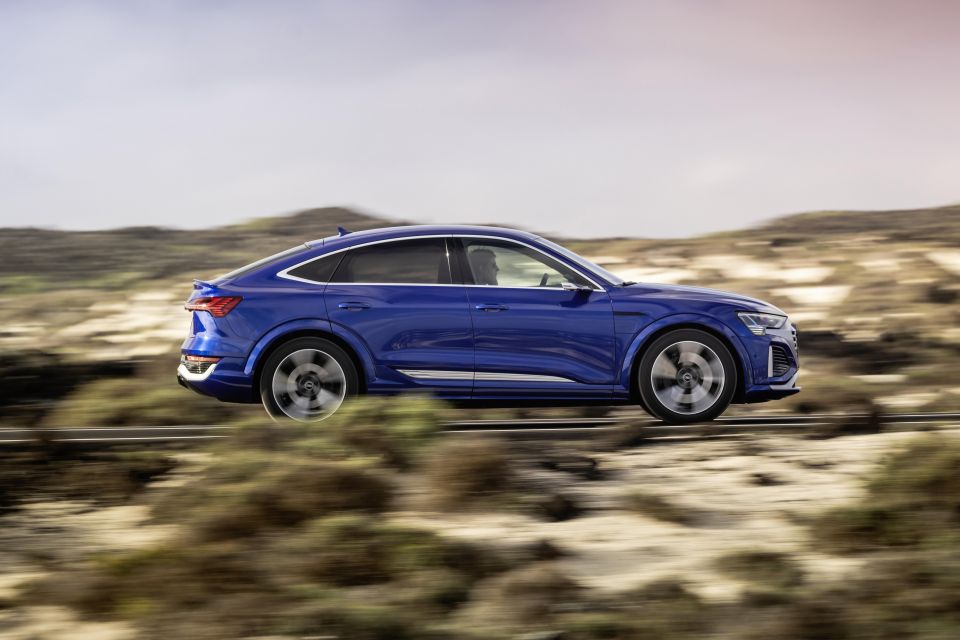
The SQ8 e-tron – like the regular Q8 e-tron – is largely free of dynamic vices and yet still has an unmistakable feeling of heft.
Our drive route lacked much in the way of tight twisties we could really throw the cars into, but while both Audi models feel polished and poised, their large dimensions and weights stop them feeling truly fun-to-drive.
A similarly large but SQ8 or RSQ8 has the edge in this respect, not just because they sound better but because they’re lighter – an SQ8 TFSI weighs around 350kg less than an SQ8 e-tron.
The driver assist features on both the Q8 e-tron and SQ8 e-tron work well. The predictive efficiency assist, in conjunction with the adaptive cruise control, starts slowing the car down when it detects a lower speed limit ahead. The lane-centring function also works commendably well.
The traffic sign recognition is generally good, though on one occasion it did mistake a 60km/h speed limit for 90km/h. Officer, I can explain…
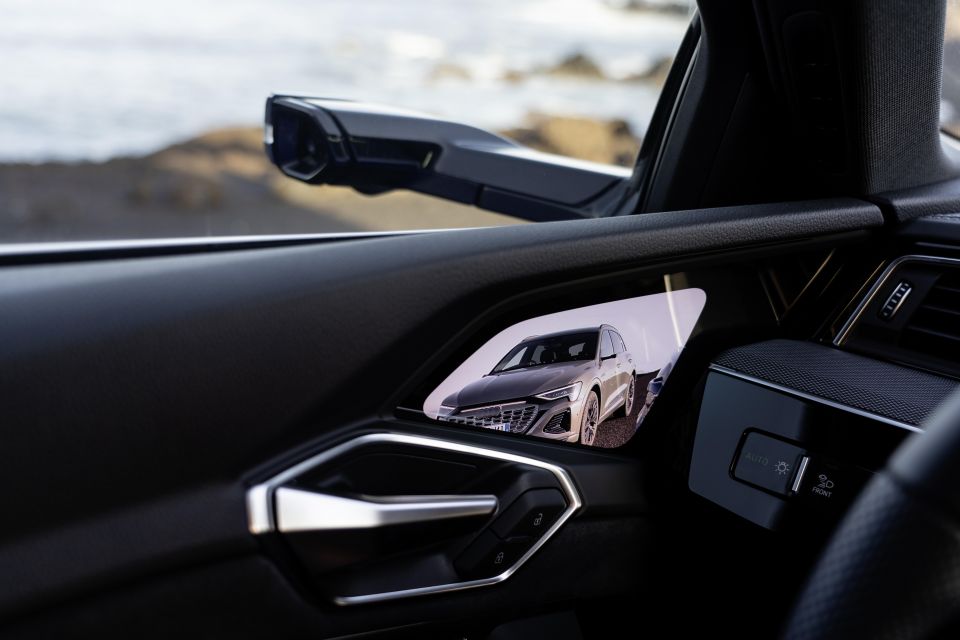
When the sun went down, we were able to observe the clever Digital Matrix LED headlights which can shine lane and orientation lights on the road.
Though we didn’t observe this on test, the lights can also draw attention to pedestrians they detect. This lighting technology is not only visually impressive, it also has serious positive implications for safety.
Much more gimmicky are the digital side mirror cameras, carried over from the e-tron. While there’s a tangible benefit in having a digital rear-view mirror inside the car – something these vehicles aren’t offered with – these camera mirrors seem rather pointless.
They take some getting used to at first and then, once you have adjusted, you wonder just what benefit they have other than some nebulous improvement to efficiency.
One other gripe: the cruise control stalk is a bit fiddly to operate, though we expect you’d get used to it with time.
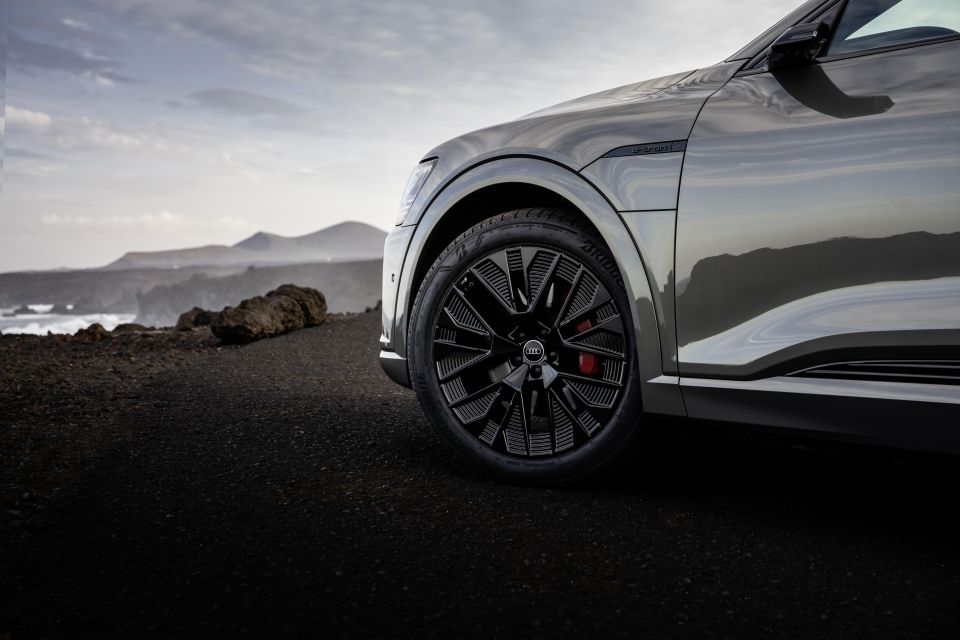
A new addition to the electric SUV range is Remote Park Assist Plus, which allows you to control the vehicle’s parking via the myAudi smartphone app.
Standard equipment in the German market includes:
The base 50 in Germany also comes with manually adjustable front seats, cloth upholstery and standard cruise control, but we wouldn’t expect to see it equipped this way here.
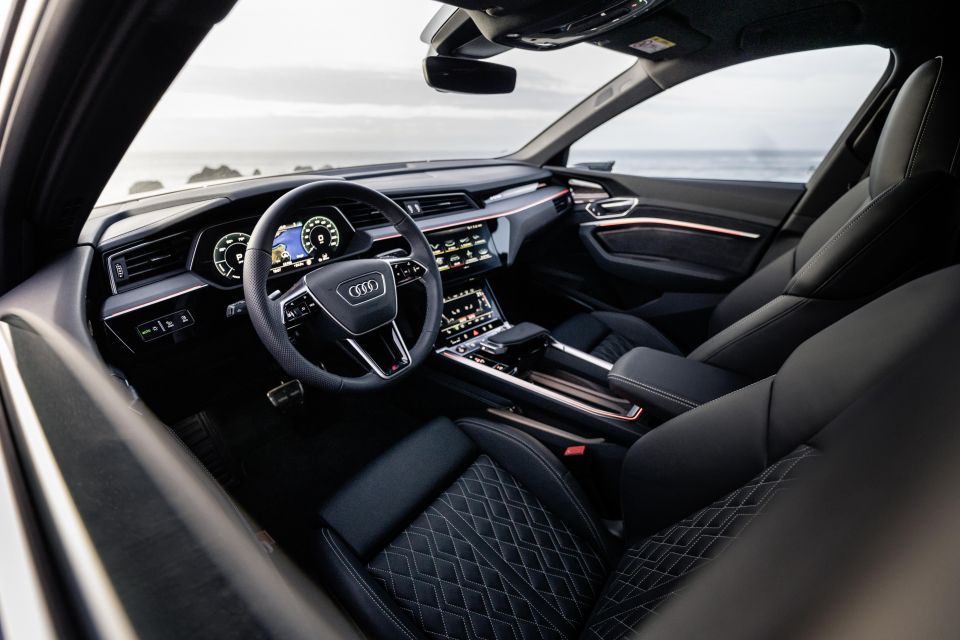
Other available features in Germany include:
Ventilation and massaging functions are available for the front seats, which have never been available on e-tron models in Australia.
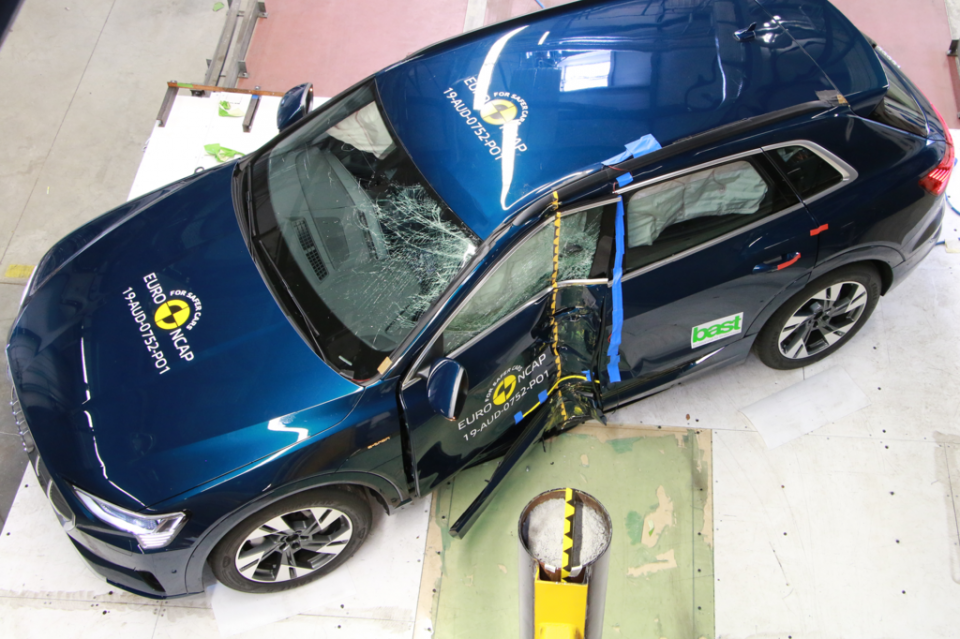
The Audi Q8 e-tron has yet to be tested by ANCAP or Euro NCAP, but the outgoing e-tron has a five-star rating based on testing conducted in July 2019.
The e-tron scored 91 per cent for adult occupant protection, 88 per cent for child occupant protection, 71 per cent for vulnerable road user protection, and 78 per cent for safety assist.
Standard safety equipment on the outgoing model in Australia includes:
The expanded suite of driver assistance features available on the new car in Germany includes junction assist for the AEB, camera-based traffic sign recognition, and an adaptive speed limiter.
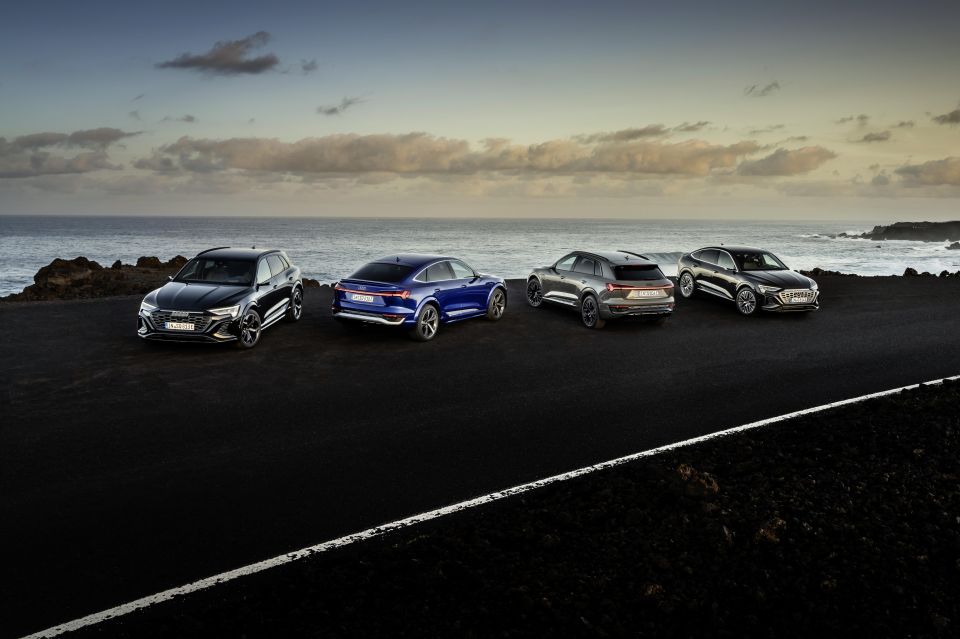
All Audi models in Australia are backed with a five-year, unlimited-kilometre warranty.
It remains to be seen whether Audi will continue to offer six years of free servicing and roadside assist and a six-year unlimited subscription to the Chargefox charging network with the Q8 e-tron and SQ8 e-tron, as it does with the outgoing model.
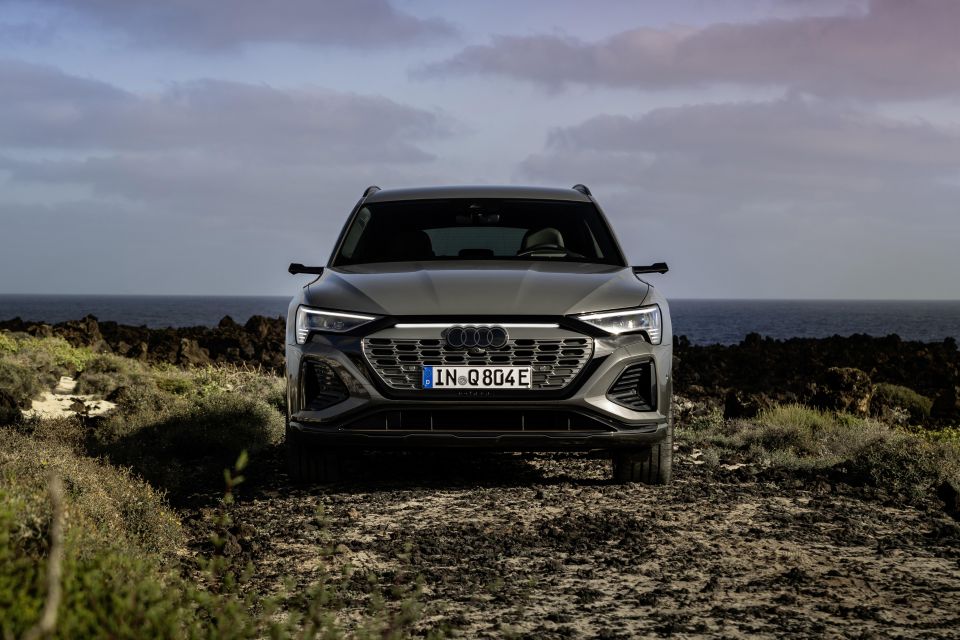
The outgoing Audi e-tron was let down by its mediocre range figures, while its similarities in look and feel to combustion-powered Audis meant it didn’t really stand out on its own against the admittedly small ranks of EV SUVs.
With new batteries and greater range, the Q8 e-tron and SQ8 e-tron now make a more convincing case, even as competition gets more heated.
They may look like Audi’s other SUVs, but as rivals range from the bulbous (Mercedes-Benz EQE SUV) to the bizarre (BMW iX), that may not be such a bad thing.

The tweaks made to the way Audi’s electric SUV drives aren’t game-changing, but further improve what was already a good thing in this regard; it remains a quiet, comfortable cruiser that never feels ponderous, though it never feels particularly thrilling either.
The almost complete lack of interior changes doesn’t bother us, though we’d like to see ventilated seats offered here and for the Volkswagen Group’s new augmented reality head-up display make its way into the car. Some more differentiation from the Q7 and Q8 wouldn’t go astray either, considering how distinctive the BMW iX’s cabin is.
In all, Audi largely made all the changes to the e-tron that we wanted it to. However, a big question mark hangs over the Q8 e-tron and SQ8 e-tron in terms of price.
Sharp pricing will help determine whether this is just a transition car for loyal Audi buyers going electric, or whether Tesla Model X and BMW iX owners should seriously take a look.
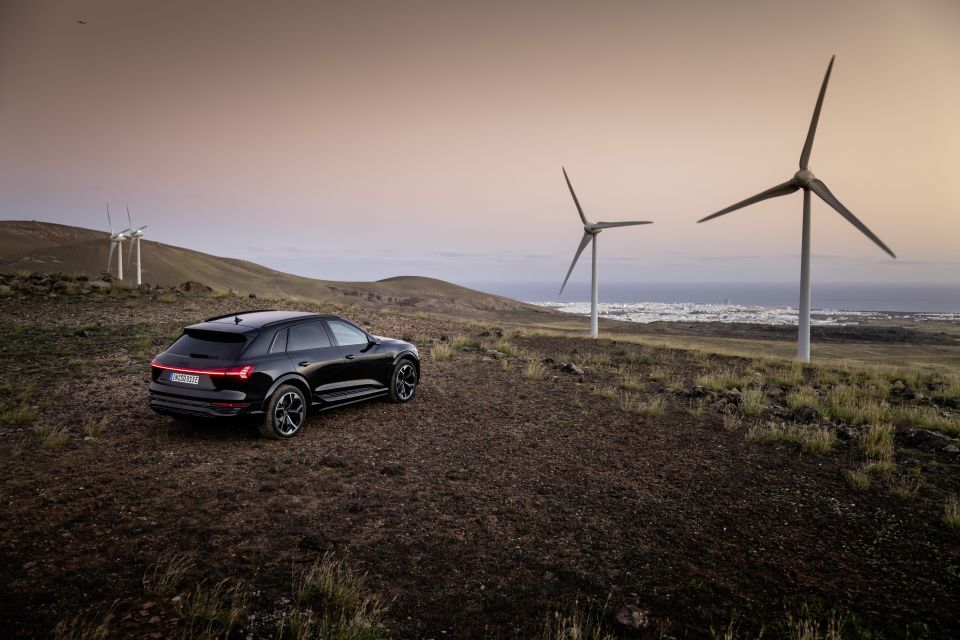
Click the images for the full gallery
Where expert car reviews meet expert car buying – CarExpert gives you trusted advice, personalised service and real savings on your next new car.
William Stopford is an automotive journalist with a passion for mainstream cars, automotive history and overseas auto markets.


Matt Campbell
7 Hours Ago


Max Davies
23 Hours Ago


William Stopford
23 Hours Ago


Derek Fung
23 Hours Ago


Max Davies
1 Day Ago


William Stopford
2 Days Ago